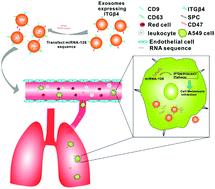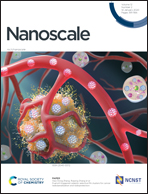Use of lung-specific exosomes for miRNA-126 delivery in non-small cell lung cancer†
Abstract
Engineered exosomes have become popular drug delivery carriers for cancer treatment. This is partially due to the interesting property, i.e. exosome organotropism, which plays an important role in organ distribution post systemic administration. Here, we demonstrated that breast cancer (MDA-MB-231) cell-derived exosomes (231-Exo) could be specifically internalized by non-small cell lung cancer cells via a specific interaction between overexpressed integrin β4 (on exosomes) and surfactant protein C (SPC) on the cancer cells. We showed that 231-Exo was capable of recognizing A549 cells in blood and effectively escaping from the immune surveillance system in vitro. Once loaded with microRNA molecules in the exosome carriers, the resulting, miRNA-126 loaded 231-Exo (miRNA-231-Exo) strongly suppressed A549 lung cancer cell proliferation and migration through the interruption of the PTEN/PI3K/AKT signaling pathway. Intravenous administration of the miRNA-126 laden exosomes led to an effective lung homing effect in mice. When tested in a lung metastasis model, miRNA-231-Exo resulted in an efficacious effect in inhibiting the formulation of lung metastasis in vivo. Collectively, our data demonstrated the possibility of using the organotropism feature of exosomes in exosome carrier design, generating a potent anti-metastasis effect in a mouse model.

- This article is part of the themed collection: Nanoscale Most Popular 2020 Articles


 Please wait while we load your content...
Please wait while we load your content...